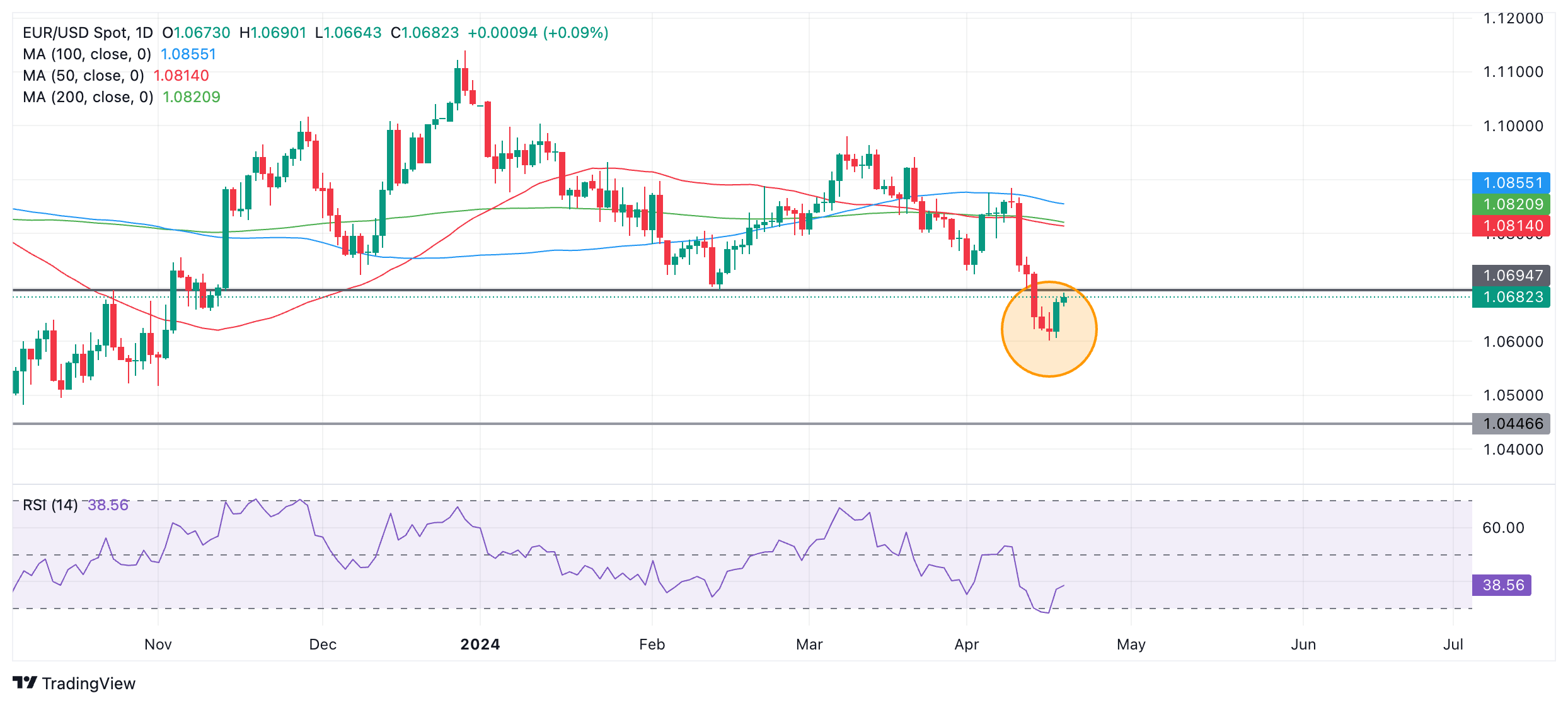- EUR/USD rallies after Lagarde says “the game is not over” on inflation.
- Slow economic growth and persistent inflation in the Eurozone could weigh on EUR/USD.
- Federal Reserve Chairman Jerome Powell talks about keeping rates higher for longer and longer.
EUR/USD is trading at 1.0680 on Thursday, slightly up on the day, taking advantage of the 180-degree turnaround that began mid-week after hitting April lows at 1.0601.
It is still early to know if EUR/USD is experiencing a bearish trend correction or a reversal, given that the strong bullish recovery recorded so far – of 80 pips in 36 hours – keeps bullish hopes alive.
EUR/USD rebound gains momentum amid doubts
The EUR/USD rebound received an additional boost from comments from European Central Bank President Christine Lagarde, who said in a speech in Washington late on Wednesday that “the game (of fighting inflation) has not finished”, despite adding that “growth in Europe is mediocre, much slower than in the United States. We clearly see timid signs of recovery.
Lagarde's comments contrast somewhat with those of some of her ECB colleagues, who have stated that inflation is behaving as it should and is on a good downward trajectory. He introduces a hint of doubt into whether the ECB will really start cutting interest rates in June, as markets believe. Maintaining higher interest rates for longer is positive for the Euro as it attracts more foreign capital inflows.
His comment that “growth in Europe is mediocre” echoes the view of currency strategists at Rabobank, who maintain that while there is no risk of a “crisis” in the region, “the combination of slow growth in the eurozone and persistent budget pressures could lower the euro's defenses going forward.” Rabobank suggests a drop to 1.0500 is likely, with risks tilted to the downside.
EUR/USD pressured by rumors of longer US rates
EUR/USD plunged in early April as bets that the Federal Reserve (Fed) would cut interest rates in June quickly faded amid stronger-than-expected inflation and strong macroeconomic data.
On Tuesday, Federal Reserve Chair Jerome Powell said high interest rates would likely remain in place for longer than expected, given little progress on inflation in recent months.
The Fed's Beige Book, a broad economic study, on Tuesday repeated the view that little progress had been made on inflation, but added that growth and employment were somewhat stronger than expected.
The Fed is expected to keep interest rates at their relatively high levels (5.5% upper limit for the federal funds rate) for a while, until the inflation monster is finally brought down.
In fact, CME's FedWatch tool, a market indicator of the likelihood of Fed rate cuts, shows only a 16% chance of a cut in June (down from more than 70% just a few weeks ago), while that the probabilities of a cut in September are now around 70%.
Technical Analysis: EUR/USD embarks on youthful recovery
EUR/USD has done a 180 degree turn after hitting a bottom at 1.0601 on Tuesday (circled). The question now, like most technical questions, is whether this is a reversal or simply a pullback in an ongoing downtrend.
EUR/USD Daily Chart
Momentum has been strong in the short time frame of the recovery so far, and the Relative Strength Index (RSI) has broken out of oversold, giving a buy signal – another good sign. However, it is too early to draw conclusions.
The medium-term bearish trend is likely to remain in place and, absent further evidence of a reversal, is likely to resume and push the exchange rate lower again.
Resistance from previous lows around 1.0700 could hamper the recovery and trigger a downward rotation. In any case, this level will offer technical resistance and a foothold for the bears, even if their cause is doomed to failure.
A break below the April lows at 1.0601 would mark a lower low and indicate a continuation of the downtrend. After that, the next concrete target is 1.0446, the October 2023 low.
Frequently asked questions about the Euro
What is the Euro?
The Euro is the currency of the 20 countries of the European Union that belong to the euro zone. It is the second most traded currency in the world, behind the US dollar. In 2022, it accounted for 31% of all foreign exchange transactions, with an average daily volume of more than $2.2 trillion per day.
EUR/USD is the most traded currency pair in the world, accounting for an estimated 30% of all transactions, followed by EUR/JPY (4%), EUR/GBP (3%) and EUR/AUD (2% ).
What is the ECB and how does it influence the Euro?
The European Central Bank (ECB), headquartered in Frankfurt, Germany, is the reserve bank of the euro zone. The ECB sets interest rates and manages monetary policy
The ECB's main mandate is to maintain price stability, which means controlling inflation or stimulating growth. Its main instrument is to raise or lower interest rates. Relatively high interest rates – or the expectation of higher rates – tend to benefit the Euro and vice versa.
The Governing Council of the ECB takes monetary policy decisions at meetings held eight times a year. Decisions are made by the heads of the eurozone's national banks and six permanent members, including ECB President Christine Lagarde.
How do inflation data influence the value of the Euro?
Eurozone inflation data, measured by the Harmonized Index of Consumer Prices (HICP), are important econometric data for the euro. If inflation rises more than expected, especially if it exceeds the 2% target set by the ECB, it is forced to raise interest rates to bring it back under control.
Relatively high interest rates compared to its peers tend to benefit the Euro, as it makes the region more attractive as a place for global investors to park their money.
How do economic data influence the value of the Euro?
Data releases measure the health of the economy and can influence the Euro. Indicators such as GDP, manufacturing and services PMIs, employment and consumer sentiment surveys can influence the direction of the single currency.
A strong economy is good for the Euro. Not only does it attract more foreign investment, but it may encourage the ECB to raise interest rates, which will directly strengthen the Euro. Conversely, if economic data is weak, the Euro is likely to fall.
The economic data for the four largest economies in the eurozone (Germany, France, Italy and Spain) are especially significant, as they represent 75% of the eurozone economy.
How does the trade balance affect the Euro?
Another important release for the euro is the trade balance. This indicator measures the difference between what a country earns from its exports and what it spends on imports during a given period.
If a country produces highly sought-after export products, its currency will appreciate due to the additional demand created by foreign buyers wishing to purchase these goods. Therefore, a positive net trade balance strengthens a currency and vice versa for a negative balance.
Source: Fx Street
I am Joshua Winder, a senior-level journalist and editor at World Stock Market. I specialize in covering news related to the stock market and economic trends. With more than 8 years of experience in this field, I have become an expert in financial reporting.








